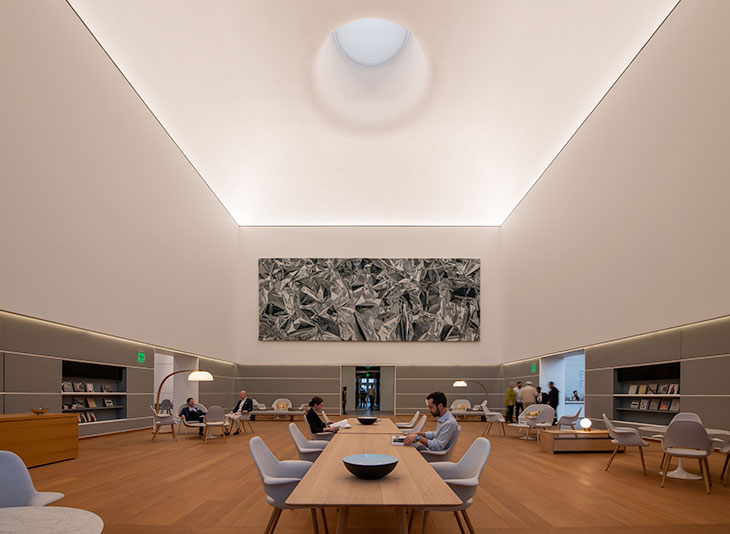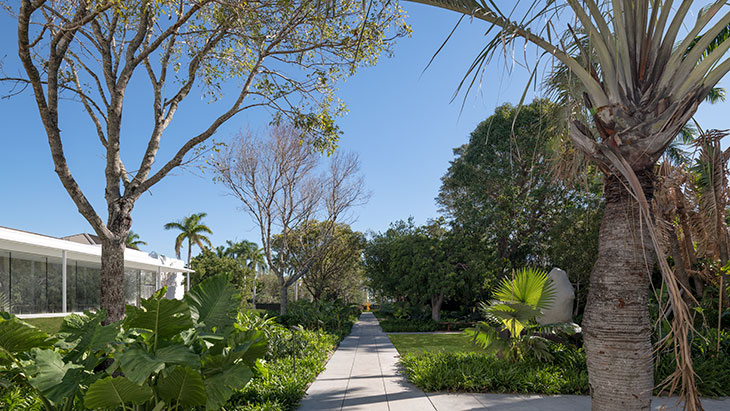An enormous sculpture by Claes Oldenburg and Coosje Van Bruggen stands outside the redesigned Norton Museum of Art in West Palm Beach, Florida, which opens to the public this month. The lower half of the sculpture features a maroon wheel rising over a reflecting pool; the upper half, a clump of blue tentacles. At a glance, it looks like a sea monster or an obscure tropical fruit, but it’s supposed to be a typewriter eraser: a forgotten artefact from the pre-PC era and, as the museum would have it, a symbol of its increased commitment to contemporary art.

Black and Blues (2017), Nina Chanel Abney. Courtesy the artist and Jack Shainman Gallery, New York; © Nina Chanel Abney
It takes guts to locate the cutting edge in a sculpture of something that most people under the age of 40 have never heard of. But after wandering through three floors of galleries displaying the museum’s permanent collections (871 of its more than 7,600 pieces are on view), as well as the temporary exhibitions, I began to think that the Norton had made a shrewd decision. The collection displays encompass 5,000 years of Chinese art, European works from 1300 to the mid 20th century, American art, photography, and global contemporary art. The inaugural exhibitions include a solo show of paintings by 37-year-old Nina Chanel Abney and an exploration of Oldenburg’s long-lasting fascination with the typewriter eraser. This museum doesn’t represent the future of art but, like the oversized gadget that welcomes visitors inside, it can be charming in its contradictions: stately and cheeky and tech-y and old-timey all at once.
A similar sense of contrast characterises the architecture of the museum. Norman Foster has a fair claim to being the most venerated architect alive, but he struck a surprisingly deferential tone towards the original 1941 building when speaking at a press preview early this month. Less than ten per cent of the pre-expansion museum’s 750,000 square feet has been rebuilt to accommodate his design, billed not as a redo so much as – this is Palm Beach, after all – a facelift. On close inspection, a few problems arise: the big, bright spaces of Foster’s 21st-century wing don’t always chime with the modest, dimly lit galleries of the original Art Deco campus, which Ralph Hubbard Norton commissioned from Marion Sims Wyeth, the architect who made tropical mansions his trademark. Long before he worked for Norton, Wyeth drew the blueprints for another Palm Beach institution (of a sort), Mar-a-Lago.

Eikón (2019) by Pae White hangs centre stage in the Ruth and Carl Shapiro Great Hall at the Norton Museum of Art. Photo: © Nigel Young/Foster and Partners
Though American museums are as dependent on the largesse of the one percent as they ever were, community outreach has become as de rigueur as Art Deco was in Wyeth’s heyday. When I spoke with Hope Alswang, the Norton’s outgoing director, she praised Foster for an ‘immensely rational plan’ that creates, among many other things, a ‘big public [area] where people can congregate’ – in effect, a warm, friendly living room for the museum. The room she’s talking about, the Ruth and Carl Shapiro Great Hall, is classic Foster: expansive yet tightly controlled, with satiny white walls and a brightly lit ceiling, punctured by an oculus to let in the Florida sunshine, which attracts more tourists in a day than a Picasso could in a year. Much as I admired the Great Hall, I doubt that its success has very much to do with populism – on that count, I was much more impressed to learn that the Norton will be waiving admission fees on Fridays and Saturdays.
The museum is often most enjoyable when it flaunts its disjointedness instead of trying to sweep it under the rug. There’s the Oldenburg sculpture out front, as well as Pae White’s tapestry, Eikón, hanging in the Great Hall. Forty feet long and inspired by the texture of glittery silver wrapping paper, it’s the rare contemporary piece that pulls off the trick of seeming grand and frothy at the same time. For I Remember Ceramic Castles, Mermaids & Japanese Bridges (the gorgeous title comes from a Joe Brainard poem), Rob Wynne scattered nearly 6,000 pieces of hand-poured glass across the walls of the museum staircase, and then stuck an ugly, macho nail through each one. In almost any other setting, I’m guessing, I would have rolled my eyes, but at the Norton the incongruity works somehow.

The gardens designed by Norman Foster at the Norton Museum of Art. Photo: © Nigel Young/Foster and Partners
The single greatest piece at the Norton, however, may be the Banyan tree by the front entrance. Eighty years old and well over 45 feet tall, it has been described by Foster (who has also designed a new 37,200-square-foot garden for the museum) as the ‘protagonist’ of the new Norton. The building’s overhang wraps around the tree, too polite to intrude any further – and this, like so much about the Norton, gives the sense of an offbeat, slightly awkward dance between old and new.
The Norton Museum of Art in West Palm Beach, Florida opens on 9 February.














![Masterpiece [Re]discovery 2022. Photo: Ben Fisher Photography, courtesy of Masterpiece London](http://zephr.apollo-magazine.com/wp-content/uploads/2022/07/MPL2022_4263.jpg)
‘Like landscape, his objects seem to breathe’: Gordon Baldwin (1932–2025)